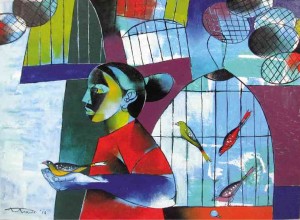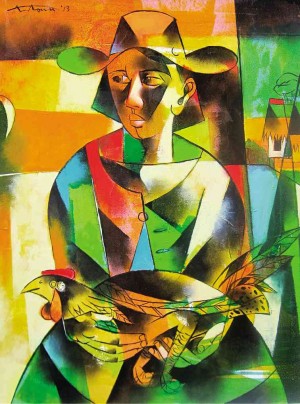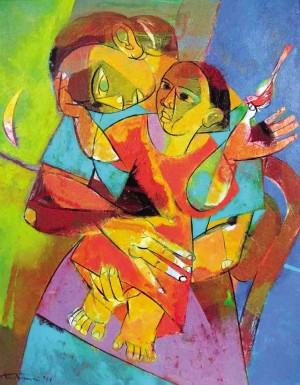
At this juncture in the development of Philippine art, a look at the Modernist movement is not only timely but necessary.
In the article “The Artistic Identity,” in a 2010 edition of Asian Arts News, art critic-scholar Reuben Ramas Cañete identified University of Sto. Tomas (UST) as having a potent mix of artists led by Victorio Edades, the leader of the Thirteen Moderns, and including no less than Galo Ocampo, Carlos “Botong” Francisco and Vicente Manansala, a group that strongly competed with University of the Philippines for the leadership of the Filipino Modern Art movement.
Unfortunately, all those stalwarts are now long gone, along with other great Modernists, such as Cesar Legaspi, H.R. Ocampo, José Joya, Federico Aguilar Alcuaz and Ang Kiukok.
A quick survey should indicate that their ranks continue to thin as there are now only Arturo Luz, BenCab, Sansó and Malang remaining.
Because of this, there’s a need to focus on the second wave of Modernists who continue to carry the torch for Modern Art. From the UST, this group includes Angelito Antonio, Antonio Austria, Norma Belleza and Mario Parial.
It is to acknowledge their contribution to Philippine art that Galerie Joaquin has put together a set of shows titled “Masters of Modernism.” This series premieres with one of the most deserving, if not the vanguard, of this group of Modernist masters, Antonio.
Prize-winner

Antonio was born to a farmer’s family from Malolos, Bulacan, in 1939. He took up Architecture at Mapua Institute of Technology, but on his second year transferred to UST in 1958. There he met the esteemed Galo Ocampo, who saw talent in the young man, gave him a scholarship, and encouraged him to join the Shell art competition.
Antonio won second place in the Oil category in 1963. It was also Ocampo who urged him to join the faculty after he graduated. It was also at UST where he met Manansala, his professor in Composition.
Antonio taught in 1963-1979. He won the Grand Prize at the Art Association of the Philippines in 1964, as well as Second and Third Prizes in the same contest in 1962 and 1964.
He was included in the initial batch of Thirteen Artists Awardees of the Cultural Center of the Philippines in 1973. Among his co-awardees were Danny Dalena and Mario Parial, also from UST.
In 1977, National Artist Luz saw his work and invited him to exhibit his monochromatic paintings of native folk done in black and white at the prestigious Luz Gallery.
Similarities, divergences
Antonio’s work shows many parallels.
Like Manansala, he paints about the Filipino way of life in a strong Cubist manner. His subjects are farmers, women, Mother and Child, fishermen, cockfight aficionados and market vendors.
Like Malang, he paints life as he sees it—native folk in camisa, pantalones, baro’t saya; sabungero holding their prized fighting cocks; vendors selling native fruits and vegetables, candles and balloons.
Like Manansala and H.R. Ocampo, he explores a nationalist style of Modernism. Like Anita Magsaysay-Ho, he paints folk and rural motifs.

However, the similarities end there. Art critics and historians have found Antonio’s work more aggressive and more expressionist.
In 1968, art critic Jolico Cuadra wrote about Antonio’ art: “He explodes them, rendering them in brisk, impatient strokes that shatter their natural boundaries. They are no longer simply decorative …[but are] now fiercely emotional symbols. The harshness of brush strokes and colors are expressionist explosions of form.”
Eric Torres described Antonio as being “good at the improvisation of the human figure.”
Today Antonio revisits his roots and goes back to themes he had explored in the ’60s and ’70s.
New energy
For “Masters of Modernism: Angelito Antonio,” he does his old themes with newfound energy.
“The works in this show are not the traditional Antonio,” he said. “I got challenged by this project and I found myself landing in a new and different plane.”
Although Antonio revisits earlier themes, he says his treatment is “more contemporary, freer, looser and less inhibited style.”
“I experimented,” he explains. “I played around with different techniques and ideas. The result is that every time I finished a piece for this show, I came up with something new, something different. I am very happy about this body of work.”
Aside from 15 major works in color and on canvas, included in the show are four sets of drawings of three to four paintings per set and 12 monochromatic paintings.
The monochromatic paintings are a development of the well-received series he had shown at Luz Gallery in 1977.
“It is in black-and-white,” Cañete wrote, “that we will see the discipline and mastery of the artist.”
Black-and-white paintings need preciseness in execution. All the ingredients from lines to massing are important to complete the composition.
The drawings can be described as “Zen in fast motion.” The works are minimalist, almost Oriental in execution; and although Zen is synonymous with tranquility and quiet, these drawings, done with minimal lines, depict movement and action.
“Except for a small show, I haven’t done a major show like this since 1988, and that is some 25 years ago,” says Antonio. “Every time I finished a painting for this show, I found it to be something different. I myself got very excited when I saw the finished product. I am very happy with this collection because the works have a new outlook. A new twist.”
“Masters of Modernism: Angelito Antonio” will open at Galerie Joaquin Main, 371 P. Guevarra St., San Juan, on July 12, and will run until July 22. Visit www.galeriejoaquin.com or call tel. 02-7239418 or 02-7239253.











































